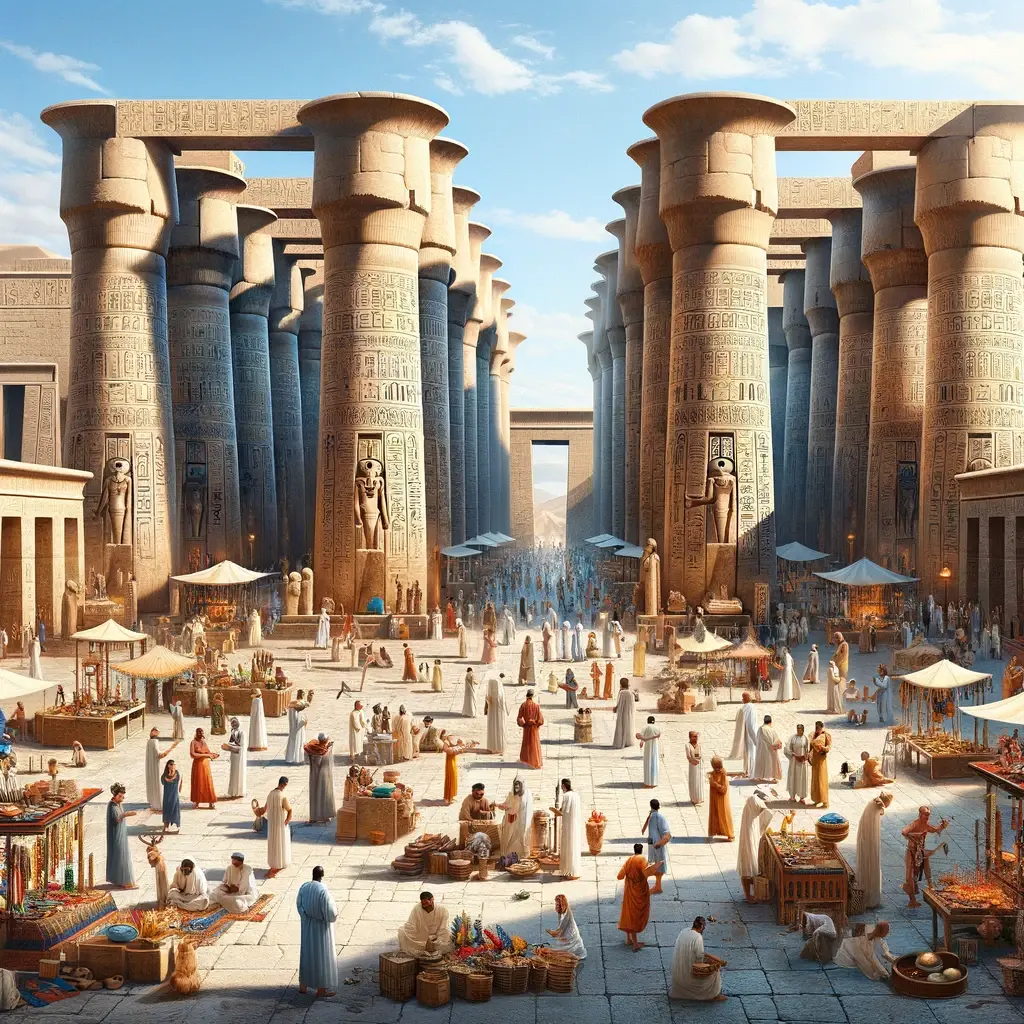
Background of Pyramid Iconography
The Ancient Significance of Pyramids
In ancient civilizations, particularly Egypt, pyramids held great spiritual significance. They were depicted as colossal stairways for pharaohs to ascend and join the gods after death. More than mere burial sites, they were grand monuments of faith, representing the Egyptians’ profound belief in life after death.
Pyramids also exemplified a cosmic symbol, their shape mirroring the descending rays of the sun. Thus, they stood as a testament to the ancient Egyptians’ reverence for the sun gods, embodying the quintessence of ascension and illumination. The black color further implied the enigma, depth, and transition into the afterlife, adding an element of transcendence.
Pyramids in Today’s Society
Modern culture often adopts symbols from ancient civilizations to represent various concepts, and pyramids have found a prominent place within this trend. In today’s society, the black pyramid is particularly seen as a symbol of strength, longevity, power, and the mysteries of the universe. Popularly viewed as enigmatic and colossal ventures of human engineering, many people associate the black pyramid with the power of illumination and intellect that transcends worldly pleasure.
Some attribute it to secrecy or enigma owing to the mystery surrounding the construction methods of the actual pyramids; conspiracy theories often relate it to extraterrestrial influence. In popular culture, the shape of the pyramid portrays a hierarchy or order, having a wide base and sharp peak. This concept is implied in business and social structures, symbolizing the journey from many starting at a broad base to the top, demonstrating achievement and success. So, pyramids, specifically the black pyramid, have become multifaceted symbols seen routinely, carrying ancient resonance into our contemporary culture.
The Color Black in Symbolism
Traditional Interpretations
Historically, the color black has held a potent position in the realm of symbolism, igniting an array of interpretations across cultures and eras. In many societies, it has traditionally been associated with mystery, power, elegance, and sophistication. In some cultures, black is considered a symbol of mourning, death, and sorrow. In ancient Egypt, black was regarded as the color of the fertile and life-giving Nile river silt, thus symbolizing fertility, regeneration, and rebirth. However, black can also represent the unknown or the incomprehensible, evoking fear or unease.
It can symbolize both the end and the beginning, embodying the full cycle of life. Therefore, a black pyramid may draw upon these connotations, serving as a symbol for the cyclical nature of life, the unknown, or the power of transformation. However, the interpretation can vary significantly based on individual perspectives, cultural contexts, and personal experiences.
Modern Views on the Black Color
In contemporary perspectives, black, illustrated by the black pyramid, embodies power, mystery, and sophistication. The shade is often associated with depth and the unknown, illustrating an aura of mystery that intrigues and entices. It symbolizes elegance and sophistication, as exhibited by prestigious brands using black for their logos to send a message of premium quality. Moreover, in the realm of power and control, black signifies dominance and authority.
This may be why it’s heavily used in formal, power-dressing, and professional settings. Furthermore, the color black may also denote negative aspects like death, fear, and darkness. However, such interpretations vary across cultures and demographics. On a more positive note, black is also connected with strength and resolve, highlighting the duality of its symbolism. Through the black pyramid, these myriad connotations of the color black can be understood and appreciated in all their complexity.
Understanding the Black Pyramid Motif
Occurrences of Black Pyramid Symbol in Pop Culture
In popular culture, the black pyramid motif surfaces regularly, attesting to its fascinating symbolism. An instance is Chris Brown’s fashion line, ‘Black Pyramid‘, where it mirrors his artistic vision and bold style. This emblem also graces the cover of prominent video games such as ‘Destiny’ and ‘Yu-Gi-Oh!’, symbolizing mystery, power, and ancient knowledge.
Movies like ‘Blade Runner’ utilize it to denote dystopian corporate control. ‘The Black Pyramid’ novel by Rick Jones carries it as a metaphor for immense power and hidden wisdom. All these instances underline the black pyramid’s representation of enigma, forbidden knowledge, power, and transformation in pop culture.
Representation in Art and Design
The black pyramid motif, often encountered in various artistic and design fields, carries powerful connotations and represents a multitude of concepts. In the context of art, the black pyramid serves as a symbol of mystery, strength, and enlightenment, reflecting the complex nature of human consciousness. This can be seen in many modern and contemporary artworks where the motif is used to embody deep philosophical thoughts. As for the sphere of design, the image of a black pyramid tends to portray a sense of sophistication, agility, and stability.
Many structural designs and logos incorporate this figure to imbue them with an aura of reliability and security. The color black also adds to this effect, which is often linked to power, elegance, and formality. A black pyramid can also symbolize a site of transformation. In graphic design, this symbol can visually translate the process of an idea coming to creation, symbolizing the transformation journey. Therefore, the black pyramid in art and design serves as an embodiment of robustness, profound thought, and evolution, making it a powerful, compelling motif.
Related: What Purpose Did Temples Serve In Ancient Egypt?
Profound Symbols Brought Together
Intersection of Pyramid and Black Color
Delving into the intrinsic meanings of both a pyramid and the color black brings about a revelation. The pyramid, in its grandeur, is a stark representation of age-old wisdom, mystery, and stability, portraying spiritual ascension. It has been a symbol of power, rooted in its historical association with the monumental structures built by ancient civilizations. Contrasting yet harmoniously blending with it, the color black embodies depth, sophistication, and often the unknown.
It is heavy with connotations of power, particularly intellectual, and speaks volumes of strength, authority, and elegance. When combined, the intersection of a pyramid and black color results in a profound symbol often associated with transcendence, knowledge, and regality. Its appealingly mysterious nature arouses intrigue. Equating the black pyramid to an enigma that beckons exploration can offer a fresh perspective on how to appreciate this multi-faceted symbol.
The Black Pyramid as a Metaphor
In exploring the depth of symbolic meanings, the image of the Black Pyramid often takes precedence as a profound metaphor. Traditionally known as a monument to power and social hierarchy, the pyramid’s imposing structure implicitly represents clear-cut social orders or levels of accomplishment. When this structure is painted black, the symbolism transcends to another level.
The black color, commonly linked to mystery, death, and the unknown, adds an additional layer of meaning, transforming the pyramid into an emblem signifying the enigmatic and possibly darker aspects of hierarchy and power. This duality of meaning offers an interesting perspective: the Black Pyramid can symbolize challenges, obstacles, or secrecy shielding pivotal knowledge. Utilized in many cultural contexts, its symbolism often carries a sense of striving or quest for enlightenment amidst imposing barriers or veiled truths. Thus, the Black Pyramid effectively straddles the line between ambition and mystery, power and obscurity.
Conclusion: The Power of Symbolism
Recap of The Black Pyramid Symbolism
Taking into account the various interpretations associated with the enigmatic black pyramid, it comes to light that these structures epitomize more than just ancient architecture. Predominantly, they represent stability, strength, and endurance, alluding to their architectural prowess and longevity over centuries. In terms of spiritual connotations, they are seen as symbols of ascension and enlightenment, embodying the idea of humans connecting with higher realms of existence. In a mystical sense, this imagery is even thought to facilitate energy convergence and spiritual elevation.
Moreover, the color black plays a crucial role, symbolizing power, mystery, and the unknown. However, in the modern world, the black pyramid has been increasingly associated with notions of rebellion and counterculture, invoking a sense of challenging the status quo. In certain contexts, it also relates to the world of fashion and entertainment. Despite the diversity of meanings, the thread that binds them is the sheer authoritative and powerful image a black pyramid commands. This illustrates the profound capacity of symbolism to transgress time and space, offering themselves to novel interpretations, thereby reminding us of its intrinsic place amidst human cognitive processes.
Wider Applications in Modern Visual Culture
In today’s visual culture, the black pyramid stretches beyond its historic and mystic roots, serving as a potent symbol in various fields. Notably used in fashion, art, and media, it often embodies strength, mystery, or transformation. Even brands such as Under Armour and designers like Kanye West have utilized it as an emblem of resilience and power.
Similarly, in films, videogames, and other popular media, the black pyramid iconography often acts as a metaphor for obscure knowledge or transcendental power. Additionally, street artists worldwide deploy this motif as a visual critique against oppressive societal systems, reaffirming its connotation of revolution.
Through these widespread uses, it’s evident that the power of black pyramid symbolism is deeply ingrained in our global visual lexicon, prolifically influencing perceptions and narratives in contemporary culture. Thus, symbolism’s power resonates universally, subtly shaping how we interpret and engage with the world around us.

